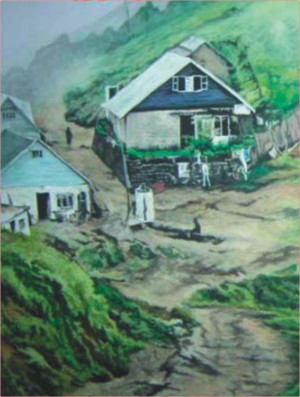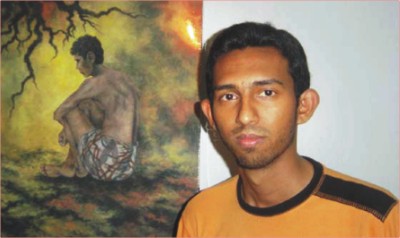| Behind the Scene
Reaching Out Differently
By Tanzila Yasmin Rumpa from Rangpur
In Journey through Bangladesh you have written about events, festivals, customs and commerce. In this section you will write about people, young and old, men and women, and their uniqueness.
He is eighteen years old but cannot hear or speak. He couldn't get the light of formal education in a school or college. But that didn't stop him from trying to express his ideas and feelings to others.
 If a man believes in his inner power and tries his best to reach his potential to the highest, nothing, not even physical disability, can stop him from fulfilling his dreams. Hasanuzzaman Himu is an evidence of the truth. If a man believes in his inner power and tries his best to reach his potential to the highest, nothing, not even physical disability, can stop him from fulfilling his dreams. Hasanuzzaman Himu is an evidence of the truth.
Himu speaks through his brush and colours. Shut up within his world of silence, he quietly absorbs the world around him with his two eyes. He then expresses his response to what he sees through his paintings. He often shows us what we usually overlook in the midst of noise.
Standing before the paintings in his room, I was simply wondering about the potential that a man may have! Within him lie so many possibilities! One just needs to awaken that sleeping genius inside. And to do that one should not be afraid of any obstacle.
In one of his pictures, Himu has depicted a fatigued man sitting under a tree. The man seems to be resting after much toil. He could be a hard-working farmer. As he is without a shirt his ribs are visible. He is sitting under a tree but the irony is that there is no leaf on the tree to provide him any shade. Himu, through his skilful handling of colour, makes the total atmosphere of the picture gloomy and sad. The posture of the man sitting on the ground and the lines on his face together with the colour in the background bring out the essential sadness and fatigue of a day labourer.
Another picture which presents a rural scene with a shanty, a hut almost on the verge of collapse attracts my attention. It stands by the side of a pond and is surrounded by different kinds of trees. A mood of serenity pervades the painting of a remote village at mid-noon. There were some joyous pictures of nature too, stacked at one corner of the room, picture of the rising sun, the deep blue sky above a lush green corn field, the rushing flow of a narrow mountain stream and others.
Himu has drawn portraits of some famous personalities such as, Rabindranath Tagore, Qazi Nazrul Islam, Sheikh Mujibur Rahman, Ziaur Rahman and a few others. In almost each of these Himu tried to portray some essential quality that he thought was unique about the personality.
Himu also portrays the darker sides of man. A big portion of his drawings is occupied by different types of masks. I was particularly fascinated by the expression of greed and selfishness in the face of one of such masks.
 |
Himu in front of his painting |
The fourth child of Md. Abdul Zabbar and Mosammet Honufa Begum, Himu is disabled in hearing and speaking from his childhood. He has got no training to be an artist. His power of keen observation has been his only teacher. He gets ideas from the pictures in newspapers, movies and the people and their lives around him. He stores everything in his mind and then expresses it on his canvas.
This is his only way of communication with the world. He talks through his pictures. While we are drowned in a world of sound and noise and are busy with our own lives, here is a young boy, forced in a world of absolute silence, trying hard to express his thoughts and emotions differently through his paintings, portraits and the masks.
Himu can be our inspiration. He teaches us to remember that every one of us, with whatever limitations we have, can find a way to live our lives with a meaning. Only, we have to know the uniqueness that is there within us, and express it.
Great Master’s Work 
Pablo Picasso(1881-1973), the famous Spanish artist and sculptor. He, in close association with Braque, initiated the Cubist movement. One of his masterpieces, Guernica, shows the destruction of the Basque town of Guernica by German bombers during the Spanish Civil War (28 April 1937).It was painted with passion as an immediate reaction to the news of the destruction of the town.
Painting, Picasso has said, “is not done to decorate apartments. It is an instrument of war for attack and defence against the enemy.” (Source: A Concise History of Modern Painting, by Herbert Read)
Picasso once fell into a conversation with an American soldier in Paris, who told him that he did not like modern paintings because they were not realistic. Picasso did not immediately respond, but when the soldier few minutes later showed him a photograph of his girlfriend, he exclaimed, “My, is she really as small as that?” (Source: The Little, Brown Book of Anecdotes)
Copyright
(R) thedailystar.net 2006 |
